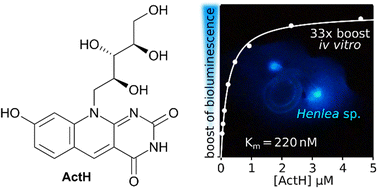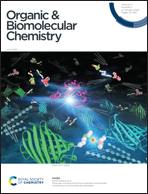Deazaflavin cofactor boosts earthworms Henlea bioluminescence†
Abstract
The bioluminescence of Siberian earthworms Henlea sp. was found to be enhanced by two low molecular weight activators, termed ActH and ActS, found in the hot extracts. The fluorescence emission maximum of the activators matches the bioluminescence spectrum that peaks at 464 nm. We purified 4.3 and 8.8 micrograms of ActH and ActS from 200 worms and explored them using orbitrap HRMS with deep fragmentation and 1D/2D NMR equipped with cryoprobes. Their chemical structures were ascertained using chemical shift prediction services, structure elucidation software and database searches. ActH was identified as the riboflavin analoge archaeal cofactor F0, namely 7,8-didemethyl-8-hydroxy-5-deazariboflavin. ActS is a novel compound, namely ActH sulfated at the 3′ ribityl hydroxyl. We designed and implemented a new four step synthesis strategy forActH that outperformed previous synthetic approaches. The synthetic ActH was identical to the natural one and activated Henlea sp. bioluminescence. The bioluminescence enhancement factor X was measured at different ActH concentrations and the Michaelis constant Km = 0.22 ± 0.01 μM was obtained by nonlinear regression. At an excess of synthetic ActH, the factor X was saturated at Xmax = 33.3 ± 0.5, thus opening an avenue to further characterisation of the Henlea sp. bioluminescence system. ActH did not produce bioluminescence without the luciferin with an as yet unknown chemical structure. We propose that ActH and the novel sulfated deazariboflavin ActS either emit the light of the Henlea sp. bioluminescence and/or accept hydride(s) donor upon luciferin oxidation.



 Please wait while we load your content...
Please wait while we load your content...